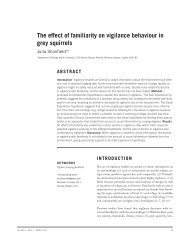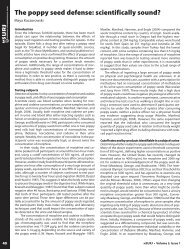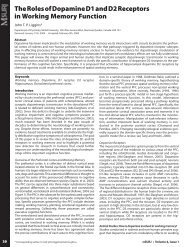the entire issue - McGill Science Undergraduate Research Journal ...
the entire issue - McGill Science Undergraduate Research Journal ...
the entire issue - McGill Science Undergraduate Research Journal ...
You also want an ePaper? Increase the reach of your titles
YUMPU automatically turns print PDFs into web optimized ePapers that Google loves.
Proof-carrying authorization in distributed systems with Beluga: a case study<br />
How to implement PCML 5<br />
in Beluga<br />
In order to implement PCML 5<br />
with Beluga, one must first encode <strong>the</strong><br />
primitive types. Beluga has no predefined data types, so this was all<br />
done by hand. An example of a piece of <strong>the</strong> authorization logic which<br />
PCML 5<br />
encodes is expressed as:<br />
Kinds K ::== Wld | A 1<br />
Affirms A 2<br />
Finally, we can represent <strong>the</strong> inference rule itself in Beluga as:<br />
isinwld_scd : is_inwld M (cross A_1 A_2) W -><br />
is_inwld (scd M) A_2 W.<br />
Lastly, we can make use of our previously implemented primitive<br />
types and inference rules to implement <strong>the</strong> main <strong>the</strong>orems of <strong>the</strong><br />
paper. Proving <strong>the</strong> <strong>the</strong>orems involves a case by case analysis on <strong>the</strong><br />
derivation of some statement in <strong>the</strong> hypo<strong>the</strong>sis of <strong>the</strong> <strong>the</strong>orem.<br />
Constructors A ::== α | A 1<br />
x A 2<br />
| A 1<br />
→ A 2<br />
These primitive types can be represented in Beluga as follows:<br />
kind : type.<br />
cnstc : type.<br />
wld : kind.<br />
affirms : cnstc -> cnstc -> kind.<br />
alpha : cnstc.<br />
cross : cnstc -> cnstc -> cnstc.<br />
arr : cnstc -> cnstc -> cnstc<br />
%type kind<br />
%type constructor<br />
Next, I implemented <strong>the</strong> inference rules. In order to do this, we make<br />
use of <strong>the</strong> fact that substitution and renaming is automatic in Beluga.<br />
Dependent types in PCML 5<br />
(e.g. lam, exists, pi etc.) are thus easily<br />
converted into Beluga. When using <strong>the</strong>se functions, a Beluga programmer<br />
need not think twice.<br />
An example of an inference rule expressed in PCML 5<br />
’s logic is:<br />
One <strong>the</strong>orem that is proven is <strong>the</strong> progress <strong>the</strong>orem. In <strong>the</strong> PCML 5<br />
paper, <strong>the</strong> statement of <strong>the</strong> <strong>the</strong>orem is written as:<br />
If m : A@w <strong>the</strong>n ei<strong>the</strong>r mval A<br />
OR ∃m′, A′, such that m ; A → w m′ ; A′.<br />
In plain English, this translates to: if m is of type A in world w <strong>the</strong>n<br />
ei<strong>the</strong>r m is a value under <strong>the</strong> assumptions A or <strong>the</strong>re is some m′ and<br />
A′ such that m evaluated under A in <strong>the</strong> world w steps to some expression<br />
m′ under A′.<br />
In order to encode this statement into Beluga, we must first somehow<br />
encode this “ei<strong>the</strong>r” in <strong>the</strong> statement. We can do this by creating<br />
a type called result, which encodes that <strong>the</strong> result is ei<strong>the</strong>r a value or<br />
an evaluation (world shift):<br />
result : term -> type.<br />
r_val : {W:cnstc}{AA:active_prin} is_val W M AA<br />
-> result M.<br />
r_ws : is_ws M AA W M’ AA’ -> result M.<br />
The statements above <strong>the</strong> horizontal line are <strong>the</strong> assumptions, while<br />
<strong>the</strong> statement below <strong>the</strong> horizontal line is <strong>the</strong> conclusion following<br />
<strong>the</strong> assumption of <strong>the</strong> statements above <strong>the</strong> line. This inference rule<br />
states that if m is of type A 1<br />
× A 2<br />
(and thus m = (m1, m2)) in <strong>the</strong> world<br />
w <strong>the</strong>n <strong>the</strong> second element (second projection) of m is of type A 2<br />
in<br />
world w.<br />
To translate this inference rule into Beluga’s language, we first must<br />
have previously declared <strong>the</strong> following types:<br />
cnstc : type.<br />
term : type.<br />
world : term.<br />
cross : cnstc -> cnstc -> cnstc.<br />
scnd : term -> term.<br />
We <strong>the</strong>n implement <strong>the</strong> “sentence structure” with which Beluga will<br />
represent m : A @ w:<br />
With this extra tool, we can now state <strong>the</strong> <strong>the</strong>orem in Beluga by following<br />
<strong>the</strong> rules for function declaration:<br />
schema apctx = active_prin ;<br />
rec thmc4 :<br />
.....<br />
{AA:[.active_prin]} [. is_inwld M A W] -><br />
[. result M] =<br />
mlam AA => fn d => case d of<br />
In <strong>the</strong> proof of this <strong>the</strong>orem, we proceed by a case by case analysis on<br />
<strong>the</strong> derivation of is_inwld M A W .<br />
In <strong>the</strong> appendix of Avijit, Datta and Harper’s paper, each possible derivation<br />
is followed by a systematic reasoning as to why <strong>the</strong> <strong>the</strong>orem<br />
would hold true under this derivation of <strong>the</strong> hypo<strong>the</strong>sis.<br />
For example, consider <strong>the</strong> derivation of is_inwld M A W , written<br />
in <strong>the</strong> appendix as:<br />
is_inwld : term -> cnstc -> cnstc -> type.<br />
Volume 8 - Issue 1 - March 2013 59









